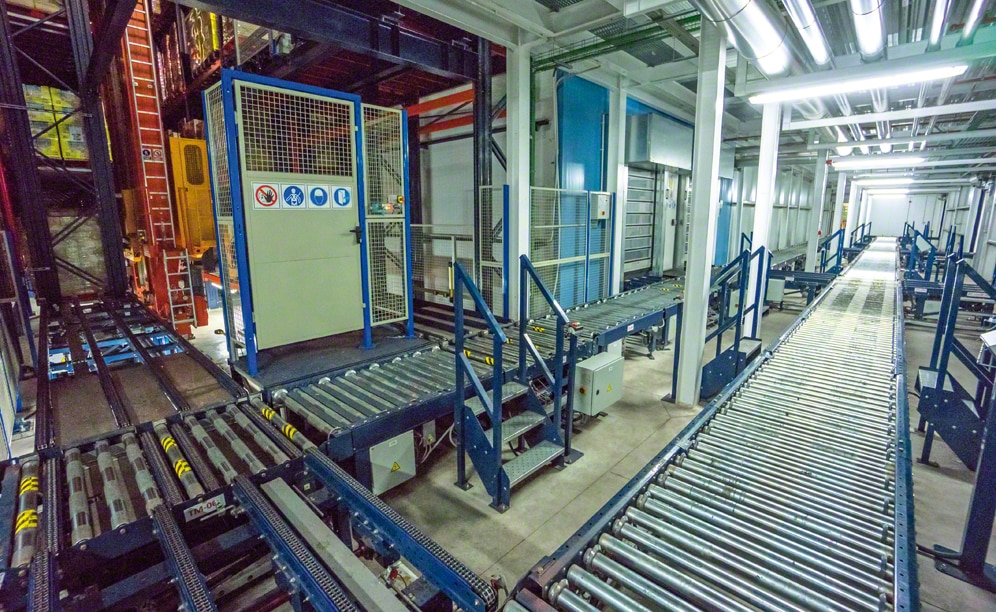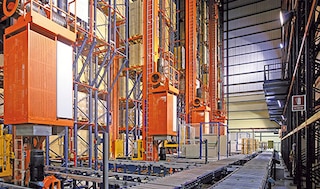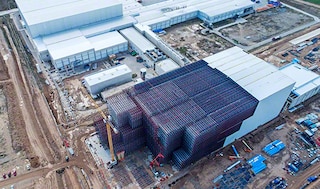
Mecalux builds an automated clad-rack warehouse with a capacity for more than 23,000 pallets
The DAFSA warehouse facility has a space purposed for future expansion

Mecalux builds DAFSA an automated clad-rack warehouse, in the scenic countryside near Valencia, whose outer finish was carefully made to be environmentally friendly. The new warehouse, with a capacity for more than 23,000 pallets, is integrated with production outputs via a two-level overpass. Mecalux's Easy WMS (warehouse management software) was supplied to control all warehouse processes.
Who is DAFSA?
DAFSA, manufacturer of juices, vegetable purees and horchata, was established in 2006 as an exclusive provider to Mercadona, Spain’s top supermarket. Strong growth experienced in recent years has made DAFSA one of the most active companies within its sector- They turn out more than 250 million litres of product a year.
In 2014, with the start-up of the new production plant in Segorbe (Castellón), that has a 66,000 m2 total surface area, it became their sector’s most advanced and sustainable production, processing and packaging factory in Europe. Within the premises, is the most noteworthy automated warehouse built by Mecalux.
The collaboration between the two companies dates back to DAFSA’s beginnings. Since then, Mecalux has built different warehouse solutions adapted to the company’s ever-changing needs.
A clad-rack warehouse: today and beyond
The design of the warehouse installed and the space reserved for future growth, which is intended to multiply storage capacity up to 40,000 pallets if needed.
In addition to the building’s own weight, the racks must bear the pallets stored and the external forces indicated by regulations, including wind.
The warehouse is 39 m high, 31 m wide and 102 m long and has four storage aisles. One of these aisles was isolated from the rest in order to store refrigerated products. To achieve this, a specific type of construction was required aimed at integrating the aisle into the same facility, but without having to install components that act as cold-bridging.
The equipment supplied by Mecalux and the warehouse management system Easy WMS is responsible for palletised product movement at the end of production lines, achieving total integration between the factory and the warehouse. This minimises the human intervention needed to move the goods between different areas.
Entrance into the warehouse: upper level
The warehouse, located on one side of the plant, is linked to production output via a two level overpass, leaving the middle area for future growth.
To enable pallets to enter the warehouse, lifts were set up at the end of the overpass to raise the load to the top level. Then a circuit of automatic conveyors is responsible for transferring pallets up to the storage aisle allocated by the Easy WMS (Warehouse Management Software).
Various checkpoints and set up ensure the size and excellent condition of the pallets coming into the warehouse. Quality control is essential, since 1,200 x 800 mm sized euro-pallets and medium sized 600 x 800 mm pallets are deposited in the same warehouse.
Inside the warehouse
High platforms were installed that coincide with the overpass’ top level, on top of which the aisle input conveyors are placed.
The warehouse is composed of four aisles where stacker cranes circulate. These are responsible for making movements between locations and the conveyors for the input and output of pallets. As mentioned previously, one of the aisles was isolated from the rest in order to store refrigerated products.
Racks, double in depth, were readied on both sides of the aisles, with 16 storage levels adapted to store the two pallet formats which DAFSA uses.
The refrigeration equipment, fire protection systems, the stacker cranes’ upper guides and the rest of internal equipment are supported and attached to the racks themselves forming an integral part thereof.
The stacker cranes are twin-mast in nature and incorporate a mounted booth to facilitate maintenance work, as shown in the photo below and to the right.
The facility is distributed in the following areas:
- Ambient temperature warehouse.
- Cold storage aisle.
- Connection overpass.
- Entries from production.
- Preloads deliveries.
- Future expansion of the warehouse.
Pallet output: lower level
Even though the top level of the overpass was intended for inputs only, on the lower level, outputs coexist with inputs, allowing for duplicate flow of inputs.
The main circuit, located on the overpass’ lower floor, has dual conveyor strands to perform pallet input and output tasks.
The main circuit of conveyors on the lower floor is connected via three doors with the conveyor circuit in the dispatch area, located in an adjoining building. Once there, two shuttles are tasked with depositing the pallets in one of the pallet flow channels available on the ground level.
Deliveries
Deliveries are also segmented depending on the product. Thereby, the part reserved for refrigerated products is built in a closed area that has a double preload capacity and vertical roll-up doors that automatically open for pallets to be deposited into the live channels.
In all, seven preload groups and a quick exit have been provided. Each group consists of three live channels with a pallet capacity of 11 each. Between them the three full loads, 33 pallets in all, fill a lorry.
The channels are prepared for the pallets, whose extraction is handled via electric pallet trucks. Preload outputs coincide with the lorry loading docks, as illustrated by the photographs on this two-page spread.
Different pallets, different solutions
The facility is outfitted to receive 800 x 1,200 mm sized euro-pallets and medium 800 x 600 mm sized pallets.
The use of medium sized pallets is very frequent in the distribution sector, especially for high consumption products, because they go directly from production to linear supermarket shelves, avoiding interim handling.
To store 800 x 1,200 mm sized pallets of indiscriminate depth with the utmost security, cross-ties were put in the racks, as shown in the picture below on the right.
The conveyors were also adapted for medium sized pallets. In the rollers, the separation between them is less than usual, while in the chain conveyors four strands are available. Furthermore, and in order to avoid confusion, checkpoints help to differentiate the two pallet types.
Easy WMS
Easy WMS is the nerve centre that governs all operations from production outputs to their dispatch. This powerful warehouse management system developed by Mecalux performs, among others, these roles:
- Management of the input of goods from production lines.
- Pallet location in the warehouse using previously parameterised rules, according to the following criteria: product type, space optimisation and maximum productivity.
- Stock management and the warehouse’s layout (what and where the goods are). Outputs to deliveries by batch and via FIFO criteria.
- Preload fulfilment according to the order requested and subsequently loading the trucks.
- Query the status of various parts of the warehouse and the machines that operate in them.
- Thanks to the Galileo control module, all movements of the different equipment that the facility is comprised of, as well as its safety measures, are managed.
The communication between Easy WMS and the customer's ERP is permanent and bidirectional, transferring the data both systems need to operate and to effectively manage the warehouse.
Advantages for DAFSA
- Increased storage capacity: The DAFSA warehouse has a capacity of more than 23,000 pallets, 800 x 1200 mm in size. The facility has a space purposed for future expansion, which allows storage capacity to be multiplied up to 40,000 pallets.
- Overall appearance: construction of a modern, high technology logistics centre, but at the same time integrated into the countryside in which it is located.
- Increased logistical efficiency: DAFSA has improved its logistical efficiency thanks to the automation of in-house movements and the connection with production outputs.
- Complete control: the Mecalux Easy MWS software manages all movements, processes and operations that take place inside the warehouse.
| Automated clad-rack warehouse | |
|---|---|
| Storage capacity:: | 23,232 pallets |
| Maximum weight per pallet:: | 1,050 kg |
| Height of the warehouse:: | 39 m |
| Type of stacker cranes:: | Double-deep, twin-mast |
| No. of stacker cranes:: | 4 |
| No. of shuttles:: | 2 |
| Preload channels:: | 21 |
| Capacity per channel:: | 11 |
| Construction system:: | Self-supporting |
Gallery

On the overpasses’ lower level is the consolidation area of the warehouse, where outputs and inputs exist side by side
Ask an expert









